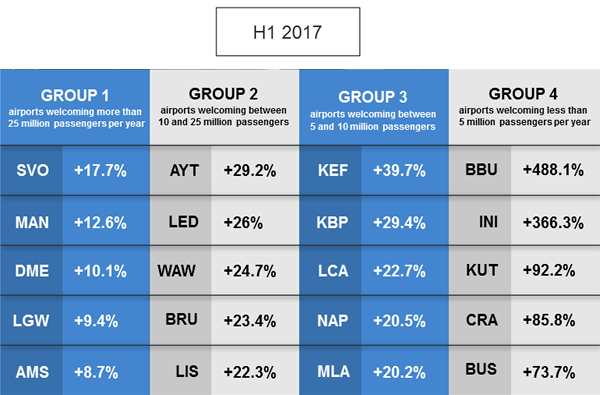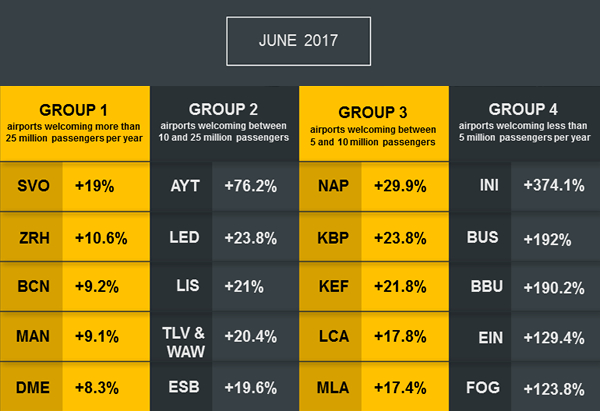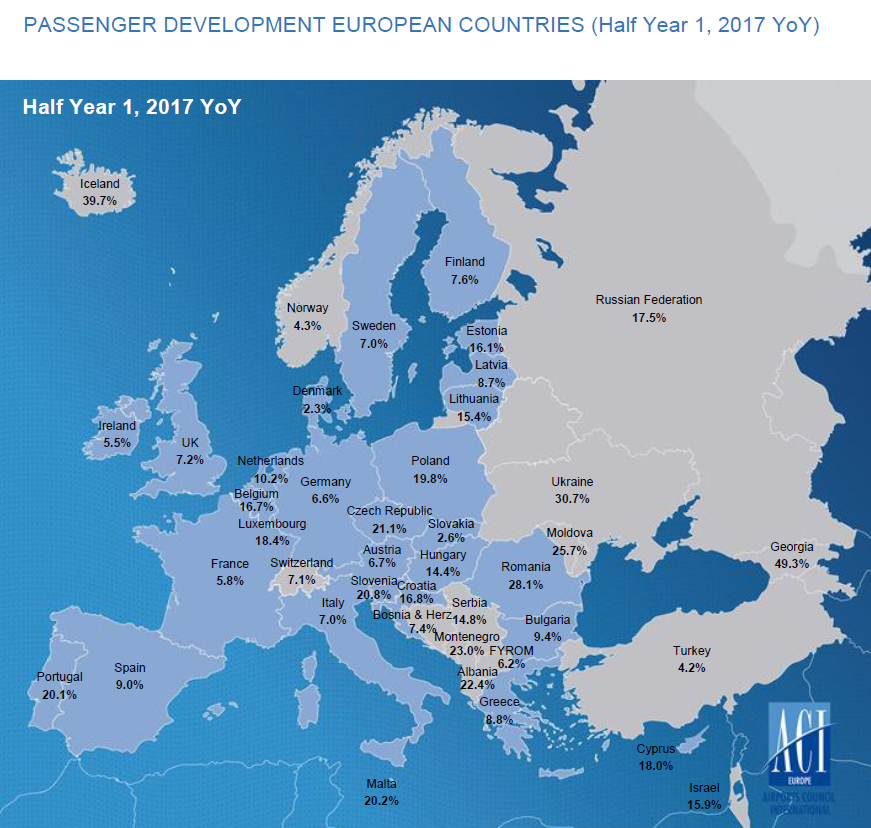EUROPE. Passenger traffic at Europe’s airports surged by +9% year-on-year in the first half of 2017, trade organisation ACI Europe reported today.
ACI Europe noted: “This impressive growth in passenger traffic was driven by a mix of one-off factors and more structural ones. These include markets affected by terrorism last year bouncing back, the return of strong passenger demand in Russia and to a lesser extent in Turkey, continued improvement in the economy and oil prices consistently remaining below US$55 per barrel.”
EU and non-EU markets posted similarly healthy growth levels in passenger traffic – respectively at +8.7% and +9.9%. In the EU, the Benelux states along with Cyprus, Malta and Portugal in the south as well as Estonia, Lithuania, Poland, the Czech Republic, Hungary, Slovenia and Croatia to the east all achieved double-digit growth. In the non-EU market, Albania, Georgia, Moldova, Montenegro and Ukraine each grew by well above +20%.


Europe’s five busiest airports recorded a passenger traffic increase of +4.3% in H1 – a notable improvement over their 2016 performance (+1.6%). Amsterdam Schiphol led the growth rates (+8.7%), followed by Paris CDG (+5.2%) and Frankfurt (+4.5%). Capacity-constrained London Heathrow still managed to grow (+3.9%), while Istanbul Atatürk regained lost ground (-1.1%).
Among secondary hubs and medium sized airports, the best performing airports included Keflavik (+39.7%), St Petersburg (+26%), Kiev (+29.4%), Antalya (+29.2%), Warsaw (+24.7%), Brussels (+23.4%), Larnaca (+22.7%), Lisbon (+22.3%), Prague (+21%), Naples (+20.5%), Malta (+20.2%), Bucharest (+20.4%), Porto and Faro (both +18.5%), Moscow-Sheremetyevo (+17.7%), Catania (+17.4%), Berlin-Schoenefeld (+17%), Tel Aviv (+17.3%), Birmingham (+16%), Toulouse (+15.2%), Valencia (+15.3%) and Milan Malpensa (+14.8%).

ACI Europe Director General Olivier Jankovec said: “For Europe’s airports, this is by far the best first half-year traffic performance in more than ten years. And this comes on top of significant growth – passenger volumes have expanded by close to +30% since 2012. This kind of growth has clearly outstripped the most optimistic forecasts – something that should be borne in mind by anyone who doubts the looming airport capacity crunch facing Europe.”
He added: “The outlook is very positive for the rest of the year with the economy – especially in the Eurozone – expected to maintain its growth trajectory and oil prices set to remain contained. Of course, this is assuming there are no new geopolitical upsets. Having said that, Brexit remains the number one worry for many airport CEOs – given the continued uncertainty surrounding negotiations. The countdown to March 2019 keeps ticking and if no progress is achieved in the coming months, we are likely to see negative impacts on aviation kick in already next year.”
During the half, airports welcoming more than 25 million passengers per year (Group 1), airports welcoming between 10 and 25 million passengers (Group 2), airports welcoming between 5 and 10 million passengers (Group 3) and airports welcoming less than 5 million passengers per year (Group 4) reported an average adjustment of +6.0%, +12.3%, +10.8% and +9.9% respectively.

The airports that reported the highest increases in passenger traffic are as follows:
Group 1: Moscow Sheremetyevo (+17.7%), Manchester (+12.6%), Moscow Domodedovo (+10.1%), London Gatwick (+9.4%) and Amsterdam (+8.7%)
Group 2: Antalya (+29.2%), St Petersburg (+26.0%), Warsaw (+24.7%), Brussels (+23.4%) and Lisbon (+22.3%)
Group 3: Keflavik (+39.7%), Kiev (+29.4%), Larnaca (+22.7%), Naples (+20.5%) and Malta (+20.2%)
Group 4: Bucharest (+488.1%), Nis (+366.3%), Kutaisi (+92.2%), Craiova (+85.8%) and Batumi (+73.7%)














